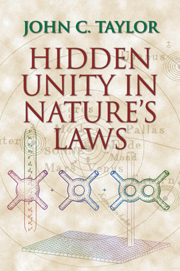Book contents
- Frontmatter
- Contents
- Preface
- 1 Motion on Earth and in the Heavens
- 2 Energy, Heat and Chance
- 3 Electricity and Magnetism
- 4 Light
- 5 Space and Time
- 6 Least Action
- 7 Gravitation and Curved Spacetime
- 8 The Quantum Revolution
- 9 Quantum Theory with Special Relativity
- 10 Order Breaks Symmetry
- 11 Quarks and What Holds Them Together
- 12 Unifying Weak Forces with QED
- 13 Gravitation Plus Quantum Theory – Stars and Black Holes
- 14 Particles, Symmetries and the Universe
- 15 Queries
- APPENDIX A The Inverse-Square Law
- APPENDIX B Vectors and Complex Numbers
- APPENDIX C Brownian Motion
- APPENDIX D Units
- Glossary
- Bibliography
- Index
3 - Electricity and Magnetism
Published online by Cambridge University Press: 20 January 2010
- Frontmatter
- Contents
- Preface
- 1 Motion on Earth and in the Heavens
- 2 Energy, Heat and Chance
- 3 Electricity and Magnetism
- 4 Light
- 5 Space and Time
- 6 Least Action
- 7 Gravitation and Curved Spacetime
- 8 The Quantum Revolution
- 9 Quantum Theory with Special Relativity
- 10 Order Breaks Symmetry
- 11 Quarks and What Holds Them Together
- 12 Unifying Weak Forces with QED
- 13 Gravitation Plus Quantum Theory – Stars and Black Holes
- 14 Particles, Symmetries and the Universe
- 15 Queries
- APPENDIX A The Inverse-Square Law
- APPENDIX B Vectors and Complex Numbers
- APPENDIX C Brownian Motion
- APPENDIX D Units
- Glossary
- Bibliography
- Index
Summary
How electricity and magnetism are different aspects of one thing.
Electric Charges
William Gilbert (1504–1603), physician to Queen Elizabeth, coined the adjective electric from the Greek word for amber. It had been known in antiquity that a piece of amber rubbed with a cloth acquired the power to attract small objects. Many other electrically insulating substances, like glass and plastics, behave similarly. An inflated rubber balloon, after being rubbed on clothing, will stick to the ceiling. Metals and damp substances are unsuitable, because any electricity generated on them leaks away immediately.
During the course of the seventeenth century, people realized that electrified objects can repel as well as attract one another. One may easily perform the following experiment at home. Cut two pieces of cooking foil about one centimetre square. Glue each of them to the end of a piece of cotton and hang them up so they are next to each other. Rub a pen on wool and bring it up to the pieces of foil. As soon as the pen touches them they jump away, then left to themselves they hang a little apart. Now rub a sherry glass on the wool and move it near the foils. It will attract them (perhaps rather weakly).
Charles-François du Fay (1698–1739), superintendent of gardens to the king of France, discovered that electric charge made by rubbing resinous material (we would use plastic nowadays) attracts that made by rubbing glass. He inferred the existence of two kinds of electricity, which we now call “positive” and “negative”. Glass rubbed with wool or cat's fur gets a positive charge. Plastics so rubbed get a negative charge.
- Type
- Chapter
- Information
- Hidden Unity in Nature's Laws , pp. 70 - 98Publisher: Cambridge University PressPrint publication year: 2001



